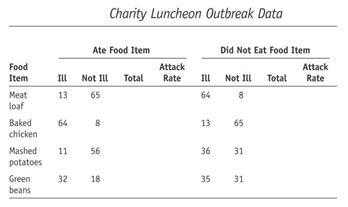Assignment:
DIRECTIONS:
This assignment is to be done alone with you as the sole author. Any work that appears to have been done in groups or with a partner will receive a zero.
QUESTIONS:
PART I: DISEASE OUT BREAK
The following exercise was adapted from: Huang, FI, and Bayona, M.."Disease Outbreak Investigation" - The Young Epidemiology Scholars Program. Supported by the Robert Wood Johnson Foundation and administered by the College Board.
One hundred and fifty people attended a charity luncheon in which two different menus were served. A total of 82 attendees reported symptoms including nausea, vomiting, abdominal cramps and diarrhea. Most of the 82 patients who became sick reported symptoms about six hours after the beginning of the lunche on. The symptoms lasted from four to seven hours. The dishes that were served included baked chicken, meat loaf, mashed potatoes and green beans. The table below shows the data collected from this investigation.

A.) Calculate the total number of people who ate and did not eat each food item.
B.) What is the formula for the attackrate?
C.) Calculate in the table above the attack rates per 100 for those who ate each fooditem.
D.) Calculate in the table above the attack rates per 100 for those who did not eat each food item.
PART II: AGENT CHARACTERISTICS
Disease X is one that often results in severe illness but is never fatal. On March 21, 2002, 80 students enrolled in an introductory epidemiology course at a university developed disease X. Assume all epidemiology students were exposed to the index case, the instructor.
Through antibody titers we were able to determine the following (antibody titers measure the concentration of antibodies in individuals and can be used to provide evidence of infection):
#of exposed students notinfected 40
#of exposed students with subclinical infection 10
#of exposed students with mild symptoms 10
#of exposed students with mode rate symptoms 10
#of exposed students with severe symptoms 10
A. Define"infectivity."
B. What is the infectivity of disease X?
C. Define"pathogenicity."
D. What is the infectivity pathogeni city of disease X?
E. Define"virulence."
F. What is virulence of disease X?